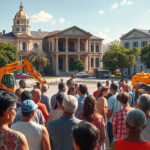Hidalgo County Vote Reflects Community Sentiment on Emergency Service District Tax Proposals
In a significant development for South Texas, Hidalgo County residents have weighed in on six propositions concerning the establishment and expansion of Emergency Service Districts (ESDs). ESDs, crucial for providing fire protection and emergency medical services in designated areas, saw varying degrees of support across the different measures proposed. This vote offers a snapshot into the community’s perspectives on taxation and public safety priorities, reflecting the unique dynamics of the Rio Grande Valley (RGV).
Voter Turnout and Proposition Outcomes
Hidalgo County voters demonstrated clear stances on the six proposals presented. Proposition 1, which sought a tax increase for an existing ESD, was opposed by 60% of voters, with 40% supporting it. Similarly, Propositions 2 and 3 faced significant opposition, rejected by 73% and 74% of voters, respectively. In contrast, Proposition 4 garnered enough support to pass, with 55% of voters in favor.
The introduction of new ESDs, namely Propositions 5 and 6, saw overwhelming approval from the community. Both propositions proposed establishing a tax rate of 10 cents per $100 valuation, a common rate for such districts. An impressive 82% of voters supported Proposition 5, and 83% backed Proposition 6, highlighting strong community interest in enhanced emergency services in areas not previously covered by any district tax.
Understanding the Context
ESDs in Texas are voter-created entities providing crucial services within a defined area, funded primarily through local taxes. These districts have become increasingly important in meeting the growing demands for fire protection and emergency medical services, particularly in rapidly expanding regions like the Valley.
But what are the implications for Valley residents? Supporting these districts often reflects a community’s readiness to invest in its safety infrastructure. In this vote, the results suggest a nuanced balance between fiscal conservatism and practical investment in public safety.
Hidalgo County Commissioner Raul Jimenez commented on the decisions, stating, “These votes show that while there is careful consideration of economic burdens, our residents recognize the value added by emergency services, especially in underserved regions. It’s a balancing act between prudent spending and necessary public safety enhancement.”
Community Impact and Future Implications
With these voting outcomes, the impact is multifaceted for the RGV. For areas under the new ESDs, residents can expect improved response times for emergency services, possibly lowering homeowner insurance costs due to enhanced fire protection measures. These services not only bolster safety but also add to the overall quality of life, making the Valley a more attractive place for potential residents and investors.
Yet, this move also brings challenges. Funding and managing these districts will require ongoing oversight. Some residents express concerns about financial sustainability and the long-term effects of increased taxes. Maria LaPorte, a McAllen resident, echoed these sentiments, stating, “While I voted for the new ESDs, there’s always uncertainty with new taxes. It’s important that the money is managed wisely, ensuring real improvements in service.”
Indeed, as Hidalgo County moves forward, transparency and accountability will play crucial roles in ensuring public trust.
Connections to Past Developments
This political decision does not occur in isolation. It ties into the broader narrative of public service enhancement in Hidalgo County. In recent years, the county has seen initiatives focusing on crisis management and bolstering public safety efforts, especially with the challenges posed by natural disasters and population growth.
The establishment of ESDs can create synergies with other public safety measures, offering a more integrated approach to emergency readiness.
A Balanced Perspective
From a broader perspective, these results provide insight into the complexity of local governance, where economic prudence and public welfare often intersect. While voters have largely resisted tax increases on existing ESDs, the enthusiastic support for new districts suggests that Valley residents are willing to invest in foundational services when articulated with clear benefits.
Hidalgo County Judge Ramon Garcia emphasized the importance of community dialogue moving forward: “It’s paramount that we continue engaging with residents, addressing their concerns, and showcasing how their contributions directly translate to community enhancements. These discussions are the bedrock of healthy civic participation.”
As the dust settles from this vote, Hidalgo County stands at a crossroads, balancing community interest and regional growth. The vote serves as a testament to the evolving priorities of Valley residents, marking a step forward in the county’s ongoing commitment to meeting public safety needs.







